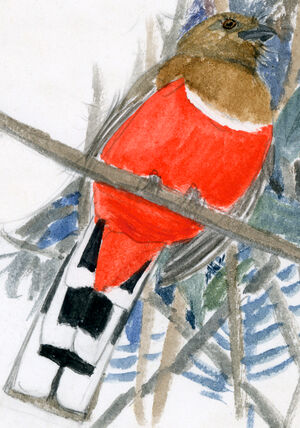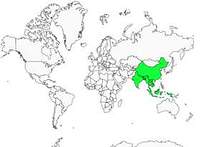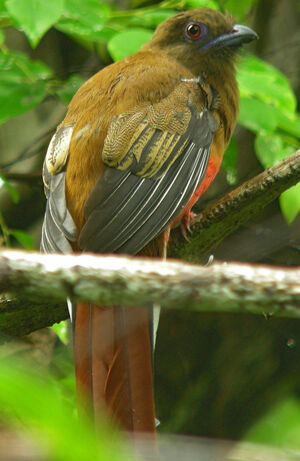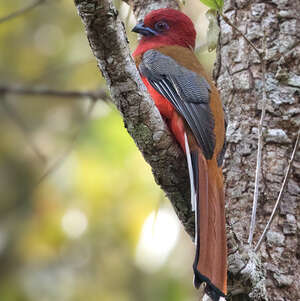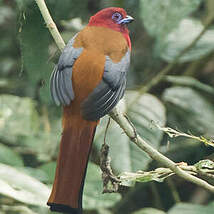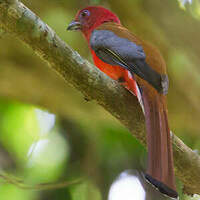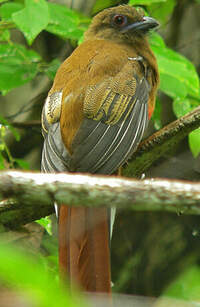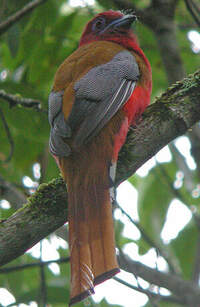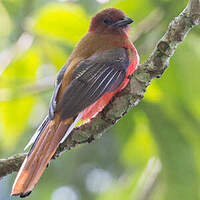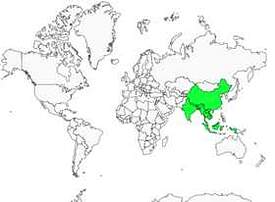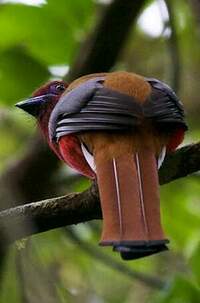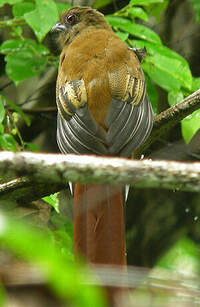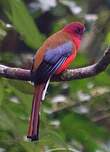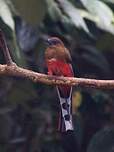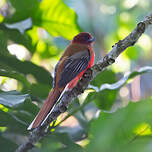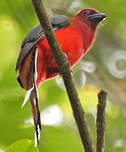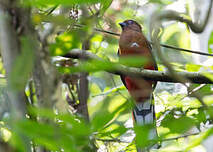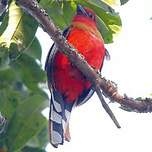Red-headed Trogon
Harpactes erythrocephalus - Trogon à tête rouge
Identification
The Red-headed Trogon, Harpactes erythrocephalus from the Greek harpax, meaning 'robber' or 'thief' and eruthros for 'red', was discovered, illustrated and named by English ornithologist John Gould (1804-1881) who worked at the Zoological Society of London and was sent bird collections from around the world. Scientists think that it is a sister species of Harpactes ardens, the Philippine Trogon and Harpactes diardii, Diard's Trogon. It is a large trogon (31-35 cm) with the distinctive color of bright red. The male has a mat red-carmine head, the beak is cobalt blue and pointed black at the tip, a wide violet-blue orbital circle frames brownish red iris, the chest and neck retain the red-carmine of the head, a fine white stripe separates the chest from the vermilion belly. The mantle, back and scapulars are brownish-red, the black coverts are vermiculated with white and the black remiges show white scale-like margins, one of the distinctive marks of many trogons. The central rectrices are dark cinnamon barred with black and the outer rectrices are white with a very visible black base. The tarsi are pale blue with mauve tips. The female has an olive-brown head, the beak remains blue but is paler than her mate's, the orbital circle is pale blue. The chest is the same olive-brown as the head and is separated from the bright red belly by a white band; the lower belly slightly reddish. The mantle, scapulae and back are orange-brown. The female has dark brown coverts vermiculated with large horizontal milky waves, the remiges have the same dark brown color and show the same white scale-like margins as males. The central rectrices are brownish-red marked with black at their tips, the outer rectrices are similar to those of the male.Juveniles have the overall colouring of their mother, brownish-olive on the head and upperparts with white or grey downy spots, the coverts usually darker for young males (which can be a good means of identification), young females having the covert feathers darker brown.
Subspecific information 9 subspecies
- Harpactes erythrocephalus erythrocephalus (c Himalayas and ne India to Myanmar and nw Thailand)
- Harpactes erythrocephalus helenae (s China and n Myanmar)
- Harpactes erythrocephalus yamakanensis (se China)
- Harpactes erythrocephalus intermedius (Yunnan. s China. , n Laos and n Vietnam)
- Harpactes erythrocephalus annamensis (ne, ecThailand, s Indochina)
- Harpactes erythrocephalus klossi (Krâvanh Mts.. w Cambodia and se Thailand.)
- Harpactes erythrocephalus chaseni (c and s Malay Pen.)
- Harpactes erythrocephalus hainanus (Hainan I.. off se China.)
- Harpactes erythrocephalus flagrans (Sumatra)
Foreign names
- Trogon à tête rouge,
- Trogón cabecirrojo,
- republicano-de-cabeça-vermelha,
- Rotkopftrogon,
- pirosfejű malájtrogon,
- Roodkoptrogon,
- Trogone testarossa,
- rödhuvad trogon,
- Rødhodetrogon,
- dravčík červenohlavý,
- trogon rudohlavý,
- Rødhovedet Trogon,
- ruusutrogoni,
- trogon capvermell,
- sędzioł czerwonogłowy,
- Красноголовый азиатский трогон,
- Luntur kepala-merah,
- ズアカキヌバネドリ,
- 红头咬鹃,
- นกขุนแผนหัวแดง,
- 紅頭咬鵑,
Voice song and call
Habitat
The Red-headed Trogon is only found in the midst of moist tropical forests from northern India to Sumatra. It prefers the understory of both deciduous and evergreen forests and is also often seen in bamboo groves. Depending on its location, it inhabits different altitudes, ranging from 250 to 1,000 meters in Nepal, from 1,800 to 2,400 meters in India, to more than 2,500 meters seen in Yunnan.
Behaviour character trait
Dietfeeding habits
A predominantly insectivorous diet, orthopterans, lepidopterans, phasmids, diplopoda (millipedes), cicadas, isopods (woodlice), and all kinds of insect larvae. It hunts from a branch but is also seen on the ground looking for its prey. Its menu also consists of bamboo leaves, various fruits, and seeds.
Reproduction nesting
Given its wide distribution area, the reproductive periods are extended: April in China, April-August in India, March-May in Myanmar. In northern India, nests have been observed in excavations of old trunks at heights between 1.5 to 5m, the Red-headed Trogon occasionally uses old nests of woodpeckers or barbets. The clutch ranges from 2 to 4 eggs, incubated in alternation or sometimes both parents together in the nest! The periods of incubation and feeding are unknown.
Geographic range
The Red-headed Trogon has the widest distribution of the Harpactes gene, and its distribution is intimately linked to the 10 subspecies! Harpactes erythrocephalus, which gives its name to the species, is present along the Himalayan Chain in North India, in the state of Uttarakhand, in Nepal, in Bhutan, to the east of Myanmar. Ssp helenae, slightly larger in size, has shorter coverts and very fine vermiculations, the belly is very red and is confined to the extreme north of Myanmar, in western China in Yunnan and south-east Tibet. Ssp yamakanensis, larger, the male has a very dark brown-carmine head and a large cinnamon brown bar above the belly that is pinker than red, the mantle and back are very dark brown and the black markings of the outer rectrices are larger, the female is very dark brown on the head and upper chest, the lower part is more cinnamon red and the belly is pink, the outer white rectrices have wider black marks, found in south-east China in the provinces of Fujian, northeast of Guangdong, south Sichuan and Guizhou. Ssp rosa, smaller, the male is similar to ssp yamakanensis, the female has a less pink ventral part and an orange-red tint on the chest, no visible white band, the mantle and back are pale olive brown, found in the north of the Autonomous Republic of Guangxi in south-east China. Ssp intermedius, the male has a pale red head and neck, the chest is red-vermillion, the ventral part is mat red without pink tones, the back and mantle are very dark brown, the vermiculations of the coverts are very fine, the female has a very dark brown head, back and mantle, the ventral part is orange red almost dark yellow, very fine light yellow vermiculations on dark brown coverts, visible in China in the south of Yunnan province, north of Vietnam and north of Laos.Ssp hainanus: the male has a red-purple head, nape and upper chest, the lower chest is paler red, mantle is very dark brown, rump and uppertail-coverts are hazel-brown, the outer rectrices have larger black markings, giving the appearance of a black tail with thinner white stripes, size is smaller than ssp erythrocephalus, the female is similar to the female erythrocephalus, the brown parts are very dark on the head, nape and chest, only on Hainan Island at the very south of China. Ssp annamensis: the male has a very yellowy colouring on the mantle and back, the feather vermiculations are coarser, the female is also more brown-yellow on the head and mantle, also conspicuous coarse vermiculations on the throat, central and south Vietnam, south Laos, extreme north of Thailand and Cambodia (except west where ssp klossi takes over). Ssp klossi: the male has a brilliant red colouring on the head and chest, the belly is deep red and without any rosy tints, mantle and back are pale brown and central rectrices too, the female is very red on the belly without rosy tints, the head is pale brown-yellow, mantle and back are pale brown, in Thailand on Koh Chang island in the Gulf of Thailand, and very southeast Thailand, Trat province and extreme west Cambodia. Ssp chaseni: the male is similar to ssp klossi but the back and central rectrices are darker brown, the black coverts are very finely vermiculated, the female has a very dark brown head, mantle and back, like the male the vermiculations are finer, only in Malaysia. Ssp flagrans: the male is similar to the nominate erythrocephalus but smaller, no detailed observations of the female, only on Sumatra in Indonesia.
Threats - protection
IUCN conservation status
concern
in the Wild
threatened
evaluated
Its enormous distribution area (2,520,000 km2), which is very varied, is surely its best protection. It is generally listed as a quite common trogon that is beginning to suffer the consequences of our demographic growth: pollution, deforestation, and unrestrained tourism.
Sources of information
- IOC World Bird List (v15.1), Gill, F and D Donsker (Eds). 2025-12-07.
- A Natural history of the Trogonidae, Joseph M.Forshaw Albert Earl Gilbert
- Scientific Birds Names, James A.Jobling
- Vol. 6 - Handbook of the Birds of the World, Josep del Hoyo-Andrew Elliott-Jordi Sargatal
- xeno-canto, Sharing bird sounds from around the world,
- Avibase, Lepage Denis
- BirdLife International, BirdLife International
- HBW Alive,
- Oriental Bird Club,
- The internet Bird Collection,
- Wikipédia, Wikipedia, The Free Encyclopedia
Other sources of interest
 Specification sheet created on
01/08/2023 by Anne et Gabriel Leboff
Specification sheet created on
01/08/2023 by Anne et Gabriel LeboffTranslation by AI Oiseaux.net
© 1996-2025 Oiseaux.net
- Accipitriformes
- Aegotheliformes
- Anseriformes
- Apodiformes
- Apterygiformes
- Bucerotiformes
- Caprimulgiformes
- Cariamiformes
- Casuariiformes
- Charadriiformes
- Ciconiiformes
- Coliiformes
- Columbiformes
- Coraciiformes
- Cuculiformes
- Eurypygiformes
- Falconiformes
- Galliformes
- Gaviiformes
- Gruiformes
- Leptosomiformes
- Mesitornithiformes
- Musophagiformes
- Nyctibiiformes
- Opisthocomiformes
- Otidiformes
- Passeriformes
- Pelecaniformes
- Phaethontiformes
- Phoenicopteriformes
- Piciformes
- Podargiformes
- Podicipediformes
- Procellariiformes
- Psittaciformes
- Pterocliformes
- Rheiformes
- Sphenisciformes
- Steatornithiformes
- Strigiformes
- Struthioniformes
- Suliformes
- Tinamiformes
- Trogoniformes

